2010 KIA SORENTO engine oil
[x] Cancel search: engine oilPage 334 of 399

Maintenance
28
7
BRAKE FLUID
Checking the brake fluid level
Check the fluid level in the reservoir peri-
odically. The fluid level should be
between MAX and MIN marks on the
side of the reservoir.
Before removing the reservoir cap and
adding brake fluid, clean the area around
the reservoir cap thoroughly to prevent
brake fluid contamination. If the level is low, add fluid to the MAX
level. The level will fall with accumulated
mileage. This is a normal condition asso-
ciated with the wear of the brake linings.
If the fluid level is excessively low, have
the brake system checked by an author-
ized KIA dealer.
Use only the specified brake fluid. (Refer
to “Recommended lubricants or capaci-ties” in section 8.)
Never mix different types of fluid.
WARNING - Brake fluid
When changing and adding brake
fluid, handle it carefully. Do not let it
come in contact with your eyes. Ifbrake fluid should come in contact
with your eyes, immediately flush
them with a large quantity of fresh
tap water. Have your eyes examined
by a doctor as soon as possible.
WARNING - Loss of brake fluid
In the event the brake system
requires frequent additions of fluid,
the vehicle should be inspected by
an authorized KIA dealer.
OXM079008
CAUTION
Do not allow brake fluid to contact the vehicle's body paint, as paintdamage will result. Brake fluid, which has been exposed to open airfor an extended time should never
be used as its quality cannot be guaranteed. It should be properlydisposed. Don't put in the wrong kind of fluid. A few drops of miner-
al-based oil, such as engine oil, in your brake system can damagebrake system parts.
Page 335 of 399

729
Maintenance
POWER STEERING FLUID
Checking the power steering fluid
level
With the vehicle on level ground, check
the fluid level in the power steering reser-
voir periodically. The fluid should be
between MAX and MIN marks on the
side of the reservoir at the normal tem-
perature.
Before adding power steering fluid, thor- oughly clean the area around the reser-
voir cap to prevent power steering fluidcontamination.
If the level is low, add fluid to the MAX
level.
✽✽ NOTICE
Check that the fluid level is in the
"HOT" range on the reservoir. If the
fluid is cold, check that it is in the
"COLD" range.
In the event the power steering system requires frequent addition of fluid, the
vehicle should be inspected by an
authorized KIA dealer.
Use only the specified power steering fluid. (Refer to "Recommended lubricants or capacities" in section 8.)
Checking the power steering hose
Check the connections for oil leaks, dam-
age and twists in the power steering
hose before driving.
CAUTION
To avoid damage to the power
steering pump, do not operate thevehicle for prolonged periodswith a low power steering fluidlevel.
Never start the engine when the reservoir tank is empty.
When adding fluid, be careful that dirt does not get into the tank.
Too little fluid can result in increased steering effort and/or
noise from the power steeringsystem.
The use of the non-specified fluid could reduce the effectiveness ofthe power steering system and
cause damage to it.OXM079009
Page 346 of 399
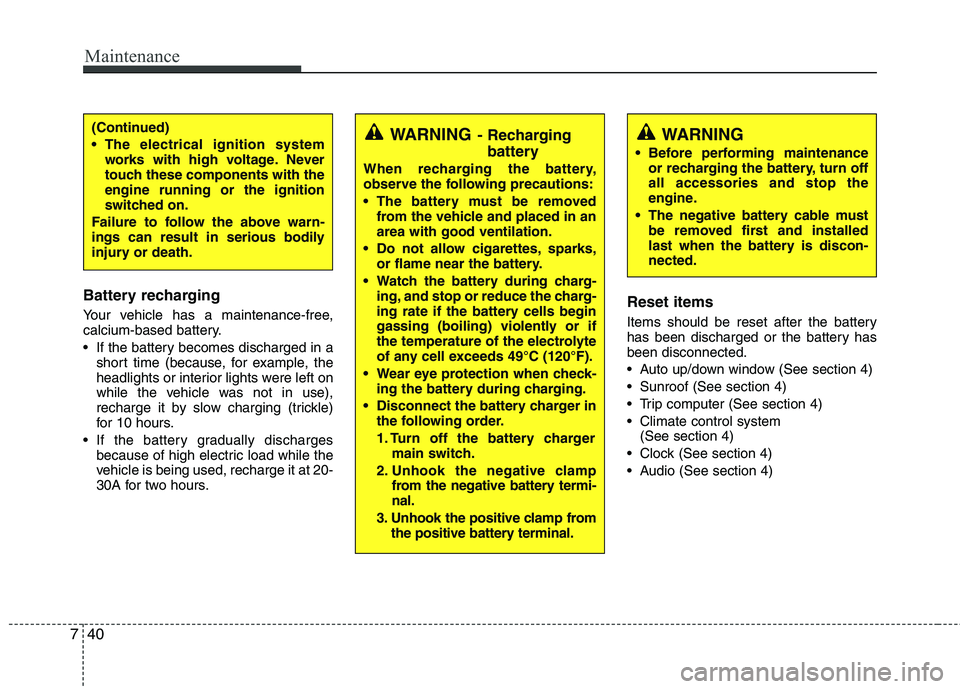
Maintenance
40
7
Battery recharging
Your vehicle has a maintenance-free,
calcium-based battery.
If the battery becomes discharged in a
short time (because, for example, the
headlights or interior lights were left on
while the vehicle was not in use),
recharge it by slow charging (trickle)
for 10 hours.
If the battery gradually discharges because of high electric load while the
vehicle is being used, recharge it at 20-
30A for two hours. Reset items
Items should be reset after the battery
has been discharged or the battery hasbeen disconnected.
Auto up/down window (See section 4)
Sunroof (See section 4)
Trip computer (See section 4)
Climate control system
(See section 4)
Clock (See section 4)
Audio (See section 4)
WARNING - Recharging
battery
When recharging the battery,
observe the following precautions:
The battery must be removed from the vehicle and placed in an area with good ventilation.
Do not allow cigarettes, sparks, or flame near the battery.
Watch the battery during charg- ing, and stop or reduce the charg-
ing rate if the battery cells begin
gassing (boiling) violently or if
the temperature of the electrolyte
of any cell exceeds 49°C (120°F).
Wear eye protection when check- ing the battery during charging.
Disconnect the battery charger in the following order.
1. Turn off the battery charger main switch.
2. Unhook the negative clamp from the negative battery termi- nal.
3. Unhook the positive clamp from the positive battery terminal.WARNING
Before performing maintenance or recharging the battery, turn off all accessories and stop the
engine.
The negative battery cable must be removed first and installed
last when the battery is discon-nected.(Continued)
The electrical ignition systemworks with high voltage. Never
touch these components with theengine running or the ignition
switched on.
Failure to follow the above warn-
ings can result in serious bodily
injury or death.
Page 365 of 399

759
Maintenance
Engine compartment main fuse panel
1 30A ECU 20A, SENSOR 1 10A, SENSOR 2 10A, SENSOR 3 10A, SENSOR 4 15A, PCU(2.4L ENGINE)20A
2
10A
3
10A
4 ECU(K3) ECU(K5) ECU(K6)
IGNITION COILCONDENSOR
IGNITION COILCONDENSOR
COOLING FAN1 RELAY IMMOBILIZER(4) CAMSHAFT POSITION SEN-
SOR 1 T2(1) CAMSHAFT POSITION SEN-
SOR 2 T2(1)
COOLING FAN 1 RELAY
PURGE CONTROL SOLENOID
VALVE(1) IMMOBILIZER(4) CRANKSHAFT POSITION SEN- SOR T2(1)PURGE CONTROL SOLENOID
VALVE
COOLING RELAY'S1' IMMOBILIZER(4) PCU(A99)
STOP SWITCH(3-N.C) STOP SWITCH(3-N.C)
10A
5 LAMBDA SENSOR(2) CRANKSHAFT POSITION SEN- SOR SENSOR DSL(3)INJECTION 1 T2(1)
INJECTION 3 T2(1)
INJECTION 2 T2(1)
INJECTION 4 T2(1)INJECTION 6
INJECTION HARNESS, INJECTION 4 PCU(A75) INJECTION 2
No. Symbol Fuse rating Protected component
DIESEL 2.4 GASOLINE 3.5 GASOLINE
ECU
3
SENSO
R1
SENSO
R2
SENSO
R3
Page 391 of 399
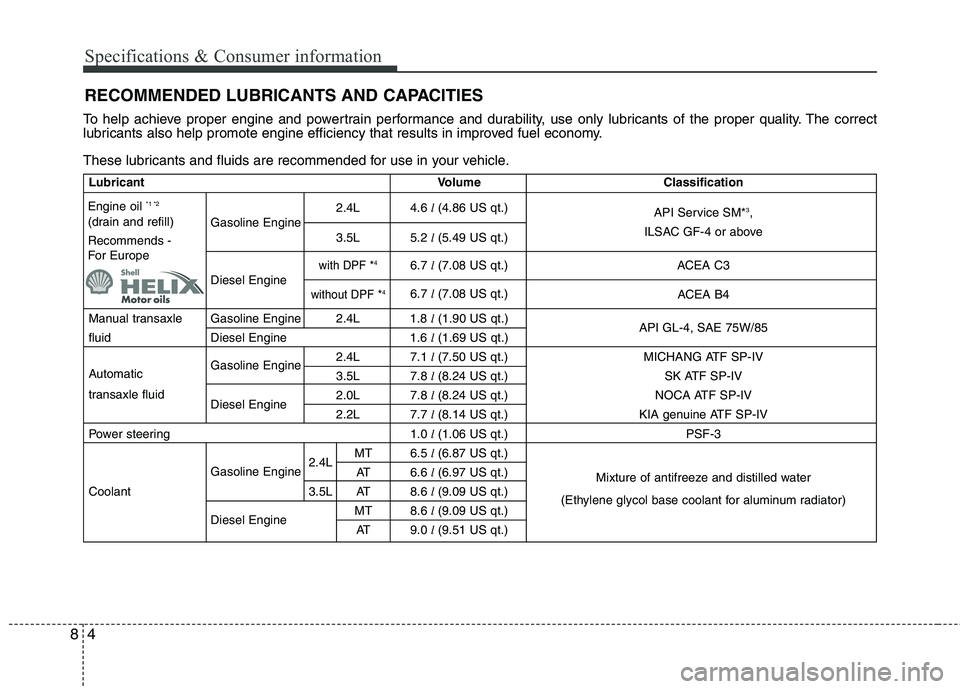
Specifications & Consumer information
4
8
RECOMMENDED LUBRICANTS AND CAPACITIES
To help achieve proper engine and powertrain performance and durability, use only lubricants of the proper quality. The correct
lubricants also help promote engine efficiency that results in improved fuel economy.
These lubricants and fluids are recommended for use in your vehicle.
Lubricant Volume Classification
2.4L 4.6 l (4.86 US qt.)
API Service SM*3
,
Gasoline Engine
3.5L 5.2 l (5.49 US qt.) ILSAC GF-4 or above
with DPF *
46.7
l (7.08 US qt.) ACEA C3
Diesel Engine 6.7 l (7.08 US qt.)
without DPF * 4ACEA B4
Manual transaxle Gasoline Engine 2.4L 1.8 l(1.90 US qt.)
API GL-4, SAE 75W/85
fluid Diesel Engine 1.6 l(1.69 US qt.)
Automatic 2.4L 7.1
l (7.50 US qt.) MICHANG ATF SP-IV
transaxle fluid Gasoline Engine
3.5L 7.8 l (8.24 US qt.) SK ATF SP-IV
Diesel Engine 2.0L 7.8
l (8.24 US qt.) NOCA ATF SP-IV
2.2L 7.7 l (8.14 US qt.) KIA genuine ATF SP-IV
Power steering 1.0 l (1.06 US qt.) PSF-3
Gasoline Engine 2.4LMT 6.5
l (6.87 US qt.)
Mixture of antifreeze and distilled water
AT 6.6
l (6.97 US qt.)
Coolant 3.5L AT 8.6 l (9.09 US qt.)
Diesel Engine MT 8.6
l (9.09 US qt.) (Ethylene glycol base coolant for aluminum radiator)
AT 9.0 l (9.51 US qt.)
Engine oil *1 *2
(drain and refill) Recommends -
For Europe
Page 392 of 399
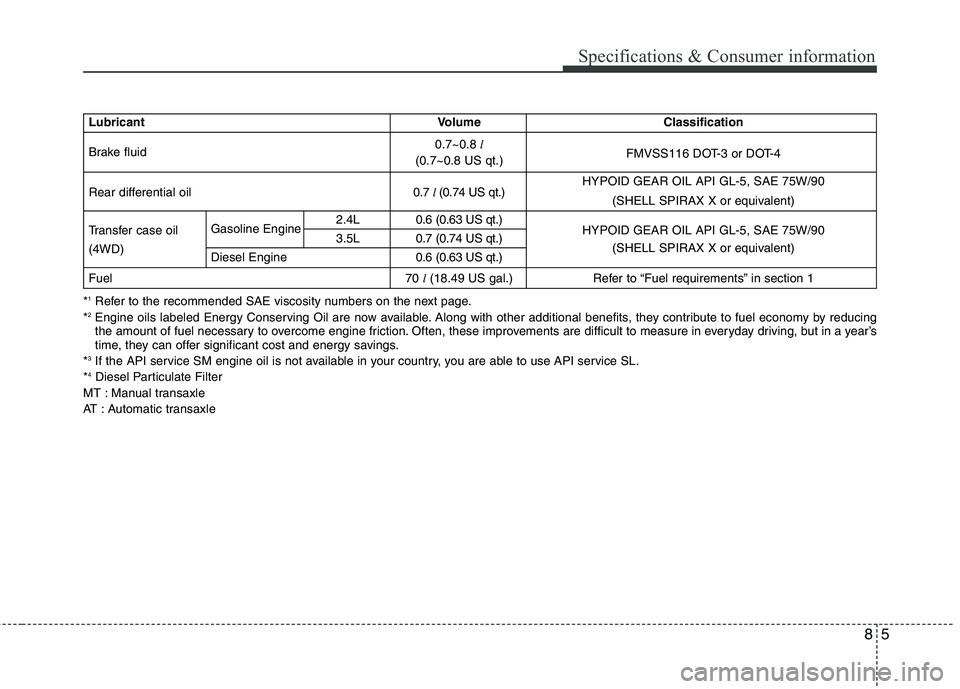
85
Specifications & Consumer information
LubricantVolume Classification
Brake fluid 0.7~0.8
l
FMVSS116 DOT-3 or DOT-4
(0.7~0.8 US qt.)
Rear differential oil 0.7 l (0.74 US qt.) HYPOID GEAR OIL API GL-5, SAE 75W/90
(SHELL SPIRAX X or equivalent)
Transfer case oil Gasoline Engine 2.4L
0.6 (0.63 US qt.)
HYPOID GEAR OIL API GL-5, SAE 75W/90
(4WD) 3.5L
0.7 (0.74 US qt.)
Diesel Engine 0.6 (0.63 US qt.)(SHELL SPIRAX X or equivalent)
Fuel 70 l (18.49 US gal.) Refer to “Fuel requirements” in section 1
*1
Refer to the recommended SAE viscosity numbers on the next page.
* 2
Engine oils labeled Energy Conserving Oil are now available. Along with other additional benefits, they contribute to fuel economy by reducing
the amount of fuel necessary to overcome engine friction. Often, these improvements are difficult to measure in everyday driving, but in a year’s
time, they can offer significant cost and energy savings.
* 3
If the API service SM engine oil is not available in your country, you are able to use API service SL.
* 4
Diesel Particulate Filter
MT : Manual transaxle
AT : Automatic transaxle
Page 393 of 399
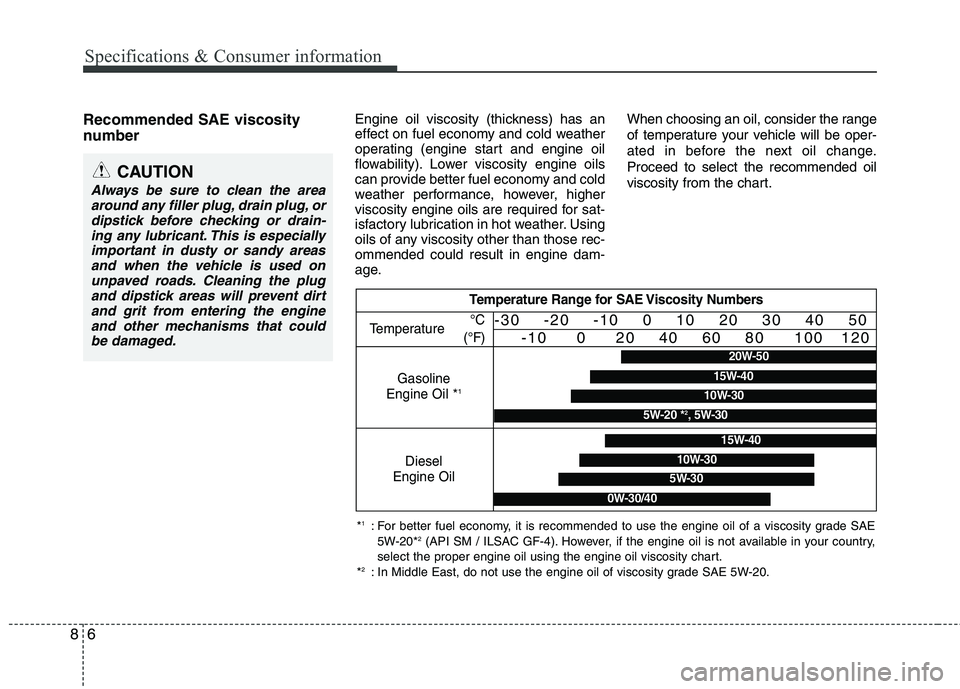
Specifications & Consumer information
6
8
Recommended SAE viscosity
number Engine oil viscosity (thickness) has an
effect on fuel economy and cold weather
operating (engine start and engine oil
flowability). Lower viscosity engine oils
can provide better fuel economy and cold
weather performance, however, higher
viscosity engine oils are required for sat-
isfactory lubrication in hot weather. Using
oils of any viscosity other than those rec-ommended could result in engine dam-
age.When choosing an oil, consider the range
of temperature your vehicle will be oper-
ated in before the next oil change.Proceed to select the recommended oil
viscosity from the chart.
CAUTION
Always be sure to clean the area
around any filler plug, drain plug, or
dipstick before checking or drain- ing any lubricant. This is especiallyimportant in dusty or sandy areasand when the vehicle is used on
unpaved roads. Cleaning the plugand dipstick areas will prevent dirtand grit from entering the engine and other mechanisms that could
be damaged.
Temperature Range for SAE Viscosity Numbers
Temperature
Gasoline
Engine Oil * 1°C
(°F)-30 -20 -10 0 10 20 30 40 50 -10 0 20 40 60 80 100 120
Diesel
Engine Oil
5W-30
15W-40
10W-30
0W-30/40
* 1
: For better fuel economy, it is recommended to use the engine oil of a viscosity grade SAE
5W-20* 2
(API SM / ILSAC GF-4). However, if the engine oil is not available in your country,
select the proper engine oil using the engine oil viscosity chart.
* 2
: In Middle East, do not use the engine oil of viscosity grade SAE 5W-20.
20W-50
10W-30
15W-40
5W-20 * 2
, 5W-30
Page 397 of 399
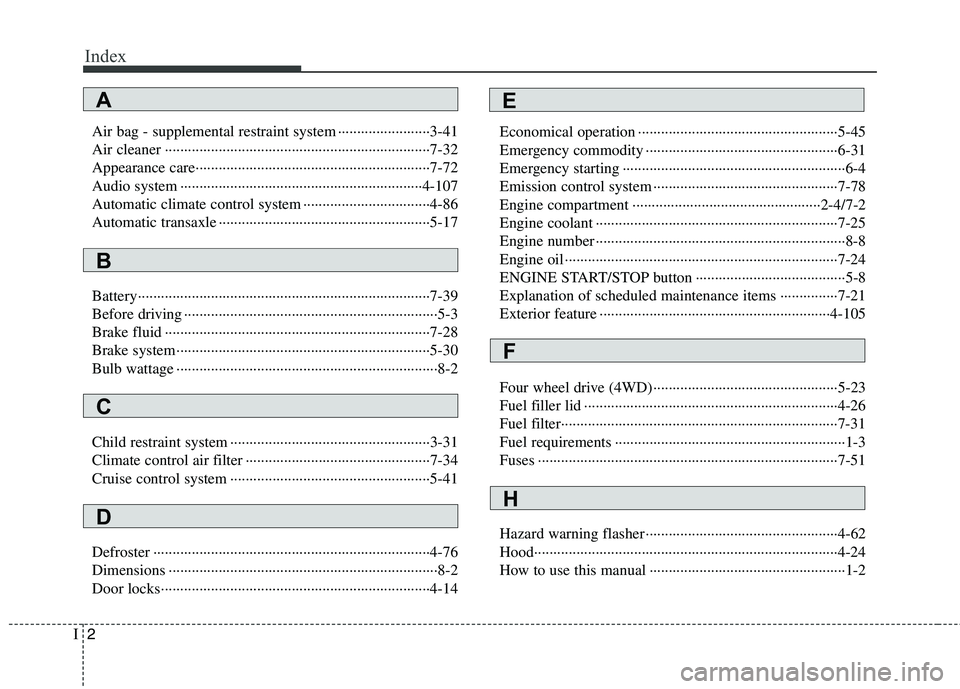
Index
2
I
Air bag - supplemental restraint system ························3-41
Air cleaner ·····································································7-32
Appearance care·····························································7-72
Audio system ·······························································4-107
Automatic climate control system ·································4-86
Automatic transaxle ·······················································5-17
Battery············································································7-39
Before driving ··································································5-3
Brake fluid ·····································································7-28
Brake system··································································5-30
Bulb wattage ····································································8-2
Child restraint system ····················································3-31
Climate control air filter ················································7-34
Cruise control system ····················································5-41
Defroster ········································································4-76
Dimensions ······································································8-2
Door locks······································································4-14 Economical operation ····················································5-45
Emergency commodity ··················································6-31
Emergency starting ··························································6-4
Emission control system ················································7-78
Engine compartment ·················································2-4/7-2
Engine coolant ·······························································7-25
Engine number ·································································8-8
Engine oil ·······································································7-24
ENGINE START/STOP button ·······································5-8
Explanation of scheduled maintenance items ···············7-21
Exterior feature ····························································4-105
Four wheel drive (4WD)················································5-23
Fuel filler lid ··································································4-26
Fuel filter········································································7-31
Fuel requirements ····························································1-3
Fuses ··············································································7-51
Hazard warning flasher ··················································4-62
Hood···············································································4-24
How to use this manual ···················································1-2
A
B
C
D
E
F
H